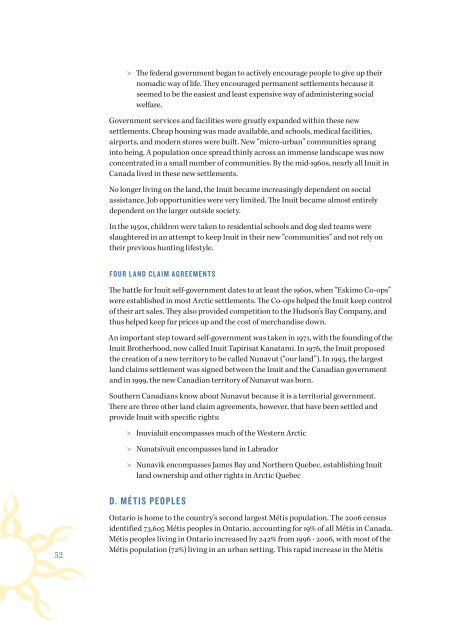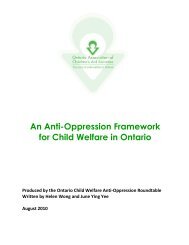English - Ontario Association of Children's Aid Societies
English - Ontario Association of Children's Aid Societies
English - Ontario Association of Children's Aid Societies
You also want an ePaper? Increase the reach of your titles
YUMPU automatically turns print PDFs into web optimized ePapers that Google loves.
The federal government began to actively encourage people to give up their<br />
nomadic way <strong>of</strong> life. They encouraged permanent settlements because it<br />
seemed to be the easiest and least expensive way <strong>of</strong> administering social<br />
welfare.<br />
Government services and facilities were greatly expanded within these new<br />
settlements. Cheap housing was made available, and schools, medical facilities,<br />
airports, and modern stores were built. New “micro-urban” communities sprang<br />
into being. A population once spread thinly across an immense landscape was now<br />
concentrated in a small number <strong>of</strong> communities. By the mid-1960s, nearly all Inuit in<br />
Canada lived in these new settlements.<br />
No longer living on the land, the Inuit became increasingly dependent on social<br />
assistance. Job opportunities were very limited. The Inuit became almost entirely<br />
dependent on the larger outside society.<br />
In the 1950s, children were taken to residential schools and dog sled teams were<br />
slaughtered in an attempt to keep Inuit in their new “communities” and not rely on<br />
their previous hunting lifestyle.<br />
FOUR LAND CLAIM AGREEMENTS<br />
The battle for Inuit self-government dates to at least the 1960s, when “Eskimo Co-ops”<br />
were established in most Arctic settlements. The Co-ops helped the Inuit keep control<br />
<strong>of</strong> their art sales. They also provided competition to the Hudson’s Bay Company, and<br />
thus helped keep fur prices up and the cost <strong>of</strong> merchandise down.<br />
An important step toward self-government was taken in 1971, with the founding <strong>of</strong> the<br />
Inuit Brotherhood, now called Inuit Tapirisat Kanatami. In 1976, the Inuit proposed<br />
the creation <strong>of</strong> a new territory to be called Nunavut (“our land”). In 1993, the largest<br />
land claims settlement was signed between the Inuit and the Canadian government<br />
and in 1999, the new Canadian territory <strong>of</strong> Nunavut was born.<br />
Southern Canadians know about Nunavut because it is a territorial government.<br />
There are three other land claim agreements, however, that have been settled and<br />
provide Inuit with specific rights:<br />
> > Inuvialuit encompasses much <strong>of</strong> the Western Arctic<br />
> > Nunatsivuit encompasses land in Labrador<br />
> > Nunavik encompasses James Bay and Northern Quebec, establishing Inuit<br />
land ownership and other rights in Arctic Quebec<br />
52<br />
D. MÉTIS PEOPLES<br />
<strong>Ontario</strong> is home to the country’s second largest Métis population. The 2006 census<br />
identified 73,605 Métis peoples in <strong>Ontario</strong>, accounting for 19% <strong>of</strong> all Métis in Canada.<br />
Métis peoples living in <strong>Ontario</strong> increased by 242% from 1996 - 2006, with most <strong>of</strong> the<br />
Métis population (72%) living in an urban setting. This rapid increase in the Métis

















